Cubic Zirconia vs Diamond: In-Depth Insights
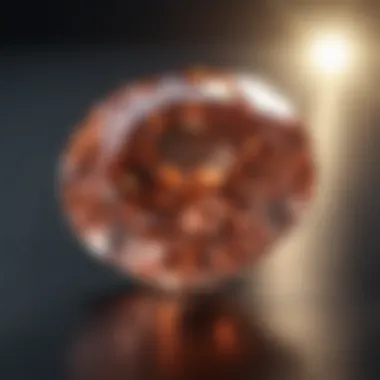
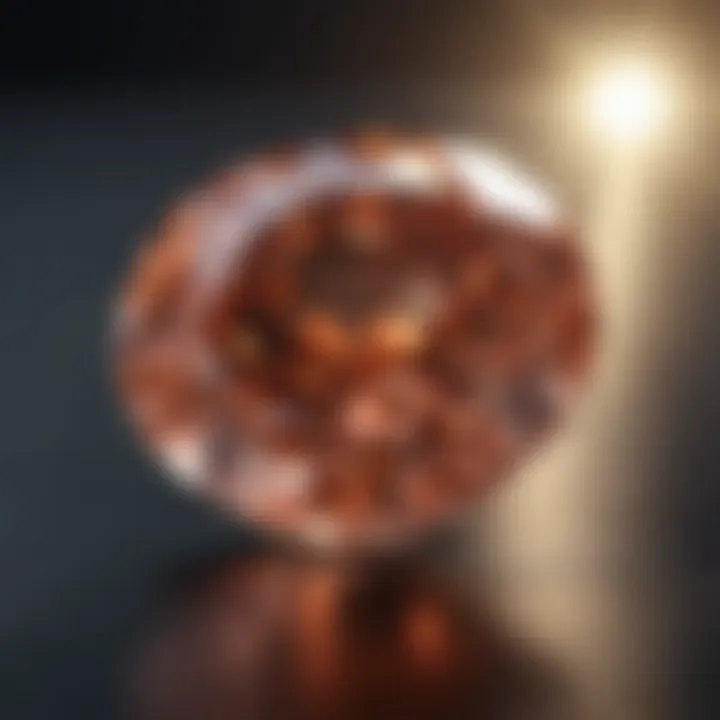
Gemstone Overview
Definition and Characteristics
Cubic zirconia and diamonds, both celebrated for their brilliance and sparkle, serve distinct purposes in the realm of gemstones. Cubic zirconia, often abbreviated as CZ, is a synthetic gemstone created in the laboratory. Its primary goal is to mimic diamonds without the extravagant price tag. On the other hand, diamonds are a product of nature’s processes, formed over millennia beneath the Earth’s surface.
Cubic zirconia boasts a remarkable hardness, rating 8-8.5 on the Mohs scale, which makes it exceptionally durable. Diamonds top the hardness chart at a flawless 10. Visually, CZ tends to exhibit more colorful flashes of light, known as dispersion, than diamonds. This effect can sometimes lead to the perception that CZ has an almost overly vibrant quality.
When considering clarity, diamonds are renowned for their unique inclusions and characteristics, often regarded as part of their story. In contrast, cubic zirconia is manufactured to be flawless, making it pristine in appearance but lacking individual character.
Classification of Gemstones
Both cubic zirconia and diamonds are categorized under the broader umbrella of gemstones but fall into differing classifications. Diamonds are classified as natural gemstones and can be further categorised by their cut, carat weight, color, and clarity, often referred to as the Four Cs. In comparison, cubic zirconia is classified as a synthetic or man-made gemstone. It does not possess the geological history associated with diamonds, emerging only from technological advancements in crystal growth processes.
Key Points:
- Cubic Zirconia:
- Diamonds:
- Synthetic gemstone
- Hardness of 8-8.5
- Often flawless, vibrant dispersion
- Natural gemstone
- Hardness of 10
- Unique inclusions, part of the gem's character
"While diamonds possess a tale of time within them, cubic zirconia tells a modern story of innovation."
Historical Significance
Ancient Uses and Cultural Importance
The historical context of gemstones reveals their deep-rooted significance across cultures. Diamonds have been cherished since antiquity, often purported to possess mystical qualities. Ancient Indians believed that diamonds could protect their bearers from hazards. The desire for these gemstones transcended beauty; they symbolized status and power, leading to their adornment by royalty.
In contrast, cubic zirconia emerged relatively recently, within the 1970s, as a more affordable alternative for consumers desiring the diamond experience without the hefty price. Its rise signifies a shift toward pragmatic choices in diamond alternatives, especially in fashion jewelry.
Myths and Legends Surrounding Gemstones
Diamonds have accumulated a wealth of myths over the ages. For instance, they’ve been viewed as symbols of eternal love, often used in engagement rings to symbolize unwavering commitment. Their allure is compounded by tales suggesting they can bring good fortune.
Conversely, cubic zirconia lacks an extensive mythology, as it is not steeped in centuries of cultural importance. Yet, it does make appearances in modern folklore, standing as a representation of affordability and accessibility in the gemstone market.
In sum, both gemstones hold valuable positions, albeit from differing perspectives in history and cultural significance. Their understanding not only aids consumers in discerning their choices but also highlights the evolving landscape of gemology.
Prelude to Gemstone Comparisons
When diving into the rich world of gemstones, a few names tend to dominate the conversation. Among them, cubic zirconia and diamonds often appear side by side, as they share a similar allure yet stem from diverging paths. Understanding the distinctions between these two jewels isn’t just useful; it's essential for anyone engaged in buying, selling, or simply appreciating precious stones. This article deciphers why it matters to compare cubic zirconia and diamonds, shedding light on their unique characteristics, market implications, and emotional significance.
Purpose of the Comparison
The purpose of comparing cubic zirconia and diamonds extends beyond surface-level aesthetics. It’s about unraveling the fabric of value, authenticity, and choices available for consumers.
- Informed Purchases: By comprehending the fundamental differences, buyers can make clever choices that suit their budgets and tastes. For some, a sparkling cubic zirconia may serve well, while others may prefer the grandeur of diamonds.
- Investment Insights: Investors need clarity on value appreciation, longevity, and resale possibilities. Knowing the distinctions informs sound investment strategies that can potentially save money and time in the long run.
- Cultural Understanding: Society often associates emotional weight with diamonds. Understanding cubic zirconia’s rise may soften that exclusive status, promoting broader acceptance of alternative gemstones.
Ultimately, this comparison serves as a guide, illuminating paths through the intricate gemstone market.
Relevance in the Gem Industry
As the gem industry ebbs and flows, the relevance of cubic zirconia and diamonds reveals itself in various ways.
- Market Dynamics: Understanding trends such as price fluctuations or shifts in consumer preferences informs how these stones are positioned in the marketplace. For instance, diamond prices can be affected by global economic factors, while cubic zirconia remains an affordable alternative, independently motivated by trends in fashion and design.
- Evolving Standards: As technology advances, new synthetic alternatives emerge, stirring debate about authenticity and consumer trust. Both cubic zirconia and diamonds have unique places in this ecological system, influencing how gemstones are valued and perceived.
- Consumer Education: Knowledge about the similarities and differences directly impacts purchasing decisions, guiding consumers toward thoughtful actions rather than impulse buys. This is particularly pivotal for those with specific stylistic or sentimental needs.
As we navigate through this analysis, keep these foundational elements in mind; they set the stage for understanding the intricate relationship between cubic zirconia and diamonds.
Understanding Diamonds
In the realm of gemstones, diamonds hold a status that is unparalleled. Recognizing their significance goes beyond mere sparkle; it delves into their complex history, formation, and the impact they have in various markets. Understanding diamonds is critical for not just gem enthusiasts but also for jewelry designers, collectors, and anyone planning to make significant investments. Each of these aspects helps provide a comprehensive perspective on why diamonds are highly sought after, often regarded as the pinnacle of gemstones.
Historical Significance
Ancient Uses
Diamonds have been celebrated since ancient times, their origins marked by a captivating story. They were coveted long before they became symbols of love and commitment. For instance, in ancient India, diamonds were worn by warriors as talismans, believed to provide invincibility in battle. This ancient use speaks volumes about the early perceptions of diamonds—things that were not merely decorative but also held a strategic significance in cultural practices.
One of the key characteristics is their durability; diamond’s hardness makes it an ideal choice for everyday wear. The practical applications in ancient societies underscore their lasting power, which remains highly relevant today. However, while diamonds were prized, they were also incredibly rare, leading to their elevated status among elites. This rarity enhances their allure but introduces a disadvantage for the average consumer who aspires to own such beauties.
Symbolism in Cultures
Diamonds have become associated with numerous emotional and cultural attributes. Their symbolism manifests vibrant tales; for instance, in Western cultures, they are synonymous with purity and eternal love, often chosen for engagement rings. The unique feature of diamond symbolism is its dual nature—desirable for both its physical properties and its emotional significance.
This begs the question: how do we measure the cultural impact of diamonds? The answer lies in their integration into various rituals and traditions spanning cultures globally. These powerful symbolic links make diamonds not just precious stones but also vessels for stories and memories. While this cultural association boosts their value, it can create unrealistic expectations for consumers, leading them to weigh emotional significance heavily against financial considerations.
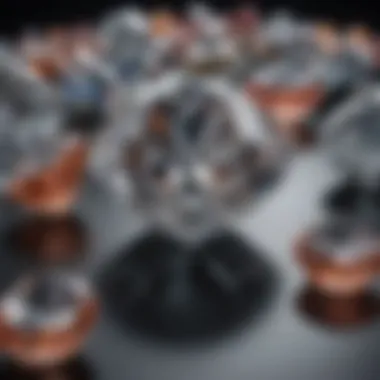
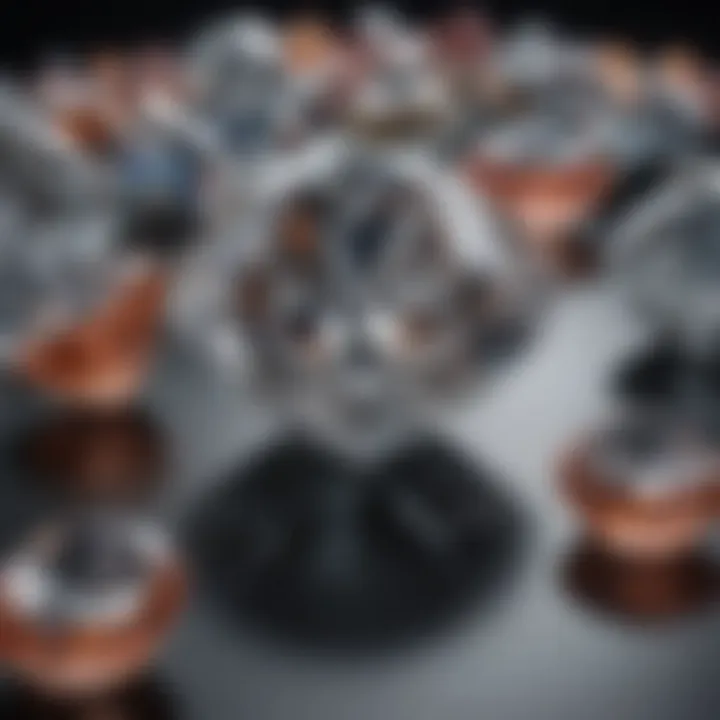
Formation Process
Natural Occurrence
The natural formation of diamonds often fascinates even the most seasoned gem enthusiasts. Formed deep within the Earth under exorbitant pressure and temperature, they undergo a metamorphosis that can take millions of years. This aspect makes them not only a natural wonder but also a subject of intrigue in geology and gemology.
What is compelling about this natural occurrence is how it becomes a testament to both the power of nature and the mystery of time. While this majesty enhances their desirability, their origin also poses challenges; natural diamonds face ethical concerns regarding mining practices and environmental impact.
Mining Techniques
When it comes to extracting diamonds, various mining techniques have evolved over the centuries. From traditional methods to advanced technology, understanding these techniques sheds light on the complexities behind bringing diamonds to market. Open-pit mining, for instance, is a common method, where earth is removed to access diamond-bearing kimberlite pipes.
The uniqueness of these mining techniques lies in their adaptive nature, as miners utilize what works best given the environment. However, these methods can have adverse effects on ecosystems, raising ethical and sustainability concerns that modern consumers are increasingly aware of. Hence, understanding mining not only accommodates the stone’s value but also introduces responsibilities that both producers and buyers must navigate.
Physical and Optical Properties
Hardness and Durability
Diamonds are renowned for their hardness, ranking a perfect 10 on the Mohs scale. This hardness plays a pivotal role in their appeal, especially for those seeking lasting investments in jewelry. Diamonds can withstand the test of time, making them a practical choice for engagement rings and other treasured pieces.
However, while it’s great that diamonds are tough, this can sometimes mislead consumers into thinking that they’re indestructible. Regular maintenance and care still play a significant role in preserving their beauty over the years, warranting a level of attention that buyers should be prepared for.
Refractive Index and Brilliance
In addition to hardness, diamonds are celebrated for their refractive properties which contribute to their stellar brilliance. The high refractive index gives them their characteristic sparkle that many fancy. This remarkable quality not only serves visually but feeds into the emotional ties we form with diamonds, connecting them to special moments.
However, this brilliance can deceive. Consumers, fraught with excitement about their potential purchase, may overlook how minor details of cut and clarity can profoundly affect appearance. Recognizing the importance of these optical properties is vital when evaluating diamonds, enhancing informed purchasing decisions.
Market Value and Trends
Current Pricing Trends
The market for diamonds is as dynamic as they come. Prices fluctuate based on availability, economic conditions, and consumer demand. What may seem like an isolated decision can affect broader market trends, especially in luxury goods. As players in the jewelry industry strive to meet consumer expectations, recognizing current pricing trends is key.
Another notable feature is the advent of lab-grown diamonds, which are reshuffling the deck. While they offer a more affordable alternative, they also create uncertainty regarding traditional diamond pricing, a factor that prospective buyers must consider.
Investment Considerations
Investing in diamonds is not a straightforward endeavor. It requires a discerning eye and an understanding of both market trends and the intrinsic value of the stone. With shifting consumer preferences, potential buyers must evaluate whether they aim for emotional satisfaction, aesthetic appreciation, or financial investment.
Investing in diamonds can be enticing due to their historical value preservation, but potential pitfalls exist, such as market volatility. Balancing these considerations is crucial for anyone contemplating a diamond investment.
In summary, understanding diamonds encompasses various factors ranging from their historical significance and physical properties to market trends. This comprehensive grasp ensures that potential buyers and jewelry enthusiasts can navigate the complexities surrounding these gemstones, leading to informed and meaningful choices.
Exploring Cubic Zirconia
Cubic zirconia, often recognized as a diamond alternative, plays a vital role in the world of gemstones. Its allure lies not just in its beauty but also in the accessibility it provides. Understanding cubic zirconia means grasping its origin, composition, and commercial position within the jewelry industry, allowing consumers and jewelers alike to make informed choices.
Origins and Development
Synthetic Creation Process
At the heart of cubic zirconia’s charm is its synthetic creation process. Unlike natural gemstones, which are formed over millennia under specific conditions, cubic zirconia is lab-created. This process involves combining zirconium oxide with stabilizers like yttrium, resulting in a clear, durable product. One key characteristic of this synthetic approach is the ability to produce cubic zirconia in various colors. The controlled environment allows for consistency in quality and appearance, making it a popular choice for costume jewelry and even fine pieces.
A unique feature of the synthetic creation process is its environmental consideration. Since cubic zirconia is made in labs rather than mined, it alleviates some ecological concerns associated with gemstone mining. However, it's crucial to note that while it offers a cost-effective alternative to diamonds, some purists argue it may lack the intrinsic value derived from natural origins.
Historical Development
The journey of cubic zirconia began in the 1970s when scientists first developed the stone, primarily for industrial applications. Over time, it gained traction in the jewelry world due to its affordability and diamond-like appearance. The key characteristic of its historical development is its shift from an industrially produced item to a mainstream jewelry alternative. This transformation demonstrates how technological innovations can reshuffle market perceptions.
While cubic zirconia is a star in its own right, some potential downsides exist. Many people still view it as less prestigious compared to natural diamonds, leading to value conversations that linger in consumers' minds.
Chemical and Physical Characteristics
Composition
The composition of cubic zirconia is straightforward yet fascinating. Primarily made of zirconium dioxide, it has a cubic crystalline structure, distinguishing it from many other gemstones. This chemical makeup contributes significantly to its optical performance, yielding a similar brilliance to diamonds at a fraction of the price.
The highlight here is that cubic zirconia can be engineered to mimic specific diamond features such as clarity and color. However, its primary disadvantage is that it's physically less enduring than diamonds, which may affect its longevity in certain jewelry applications.
Comparison of Hardness
When it comes to hardness, cubic zirconia scores a respectable 8-8.5 on the Mohs scale, making it tougher than many stones but still softer than diamonds, which measure a flawless 10. This difference is vital for consumers considering durability in their jewelry choices.
The main takeaway of this comparison lies in practicality. If a stone is meant for daily wear, its hardness is substantial—cubic zirconia can scratch and show wear more quickly than diamond. Thus, while cubic zirconia has its merits, obtaining a diamond might be wiser for those who desire lasting durability.
Aesthetic Qualities and Limitations
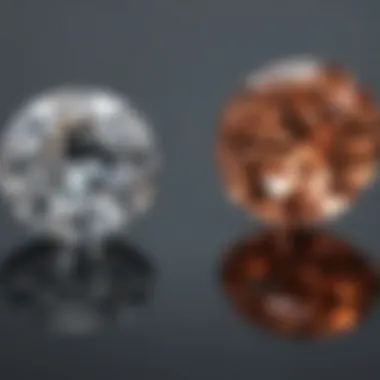
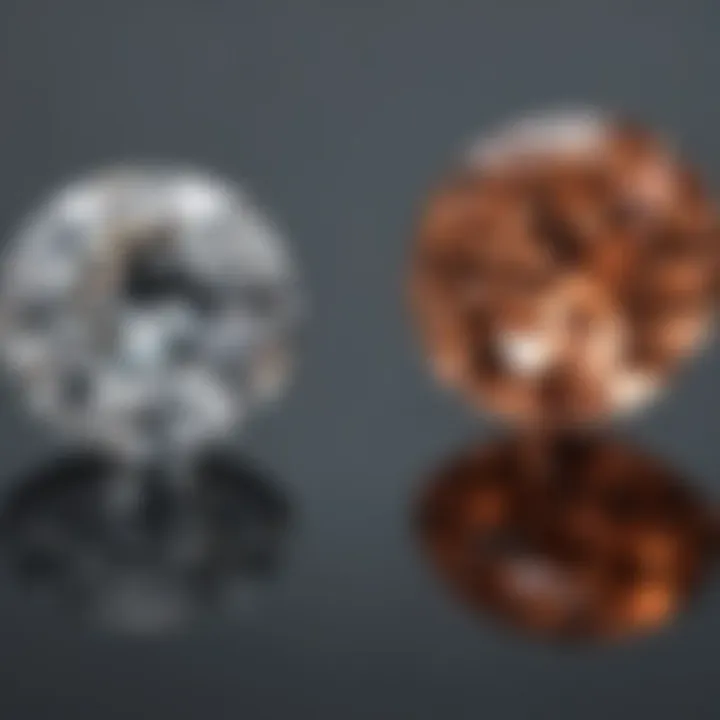
Clarity and Color Variations
Cubic zirconia is renowned for its clarity, often achieving a pristine appearance that's hard to rival. Moreover, the color variations available can be stunning. From traditional clear forms mimicking diamonds to vibrant hues like pink, blue, or even bright yellow, the options are practically endless.
However, there's a catch. Some of these colors can be created artificially, leading to questions about authenticity and value. While aesthetically appealing, these variations may come at the cost of perceived value by some consumers, especially those who prioritize natural stones.
Comparison of Sparkle
One of the most talked-about elements of cubic zirconia is its sparkle. With a higher refractive index than diamonds, cubic zirconia can emit a dazzling brilliance, capturing attention. Many individuals find this sparkle appealing, especially for statement pieces or fashion jewelry.
Nevertheless, excessive sparkle can lead some to regard it as less sophisticated compared to the more nuanced shine of a diamond. In essence, the distinction lies in preference—some people adore the vibrant shine of cubic zirconia, while others appreciate the understated elegance that diamonds bring.
Commercial Aspects
Pricing Structure
Cubic zirconia shines in terms of pricing. Generally, it is much less costly than diamonds, often translating to significant savings for consumers. This accessible pricing attracts a broad audience, including those who love beautiful jewelry without burdensome expenses.
Still, the trade-off here is that lower pricing can come with perceptions of lower quality. As a result, consumers may feel that cubic zirconia doesn't carry the same weight as diamonds, which can impact their purchasing decisions in a meaningful way.
Market Demand Trends
The market demand for cubic zirconia has seen growth over the years, fueled by the rising preference for ethical and affordable options in jewelry. As consumers become more conscious of sourcing and price, cubic zirconia is often viewed as a smart choice, especially amid economic shifts.
Nonetheless, there's a dual aspect to this trend. While cubic zirconia may thrive in particular consumer demographics, the traditional luxury market still tends to favor diamonds. Understanding these trends helps potential buyers navigate their choices, particularly in jewelry investment and purchasing.
Key Differences Between Diamonds and Cubic Zirconia
Understanding the key differences between diamonds and cubic zirconia is essential for anyone looking to dive into the world of gemstones. Not only does this comparison highlight their unique characteristics, but it also offers insights into the emotional value and market dynamics surrounding these stones.
When consumers are faced with choices regarding purchasing or investing in jewelry, knowing what sets these two apart can make a significant difference. It goes beyond just the visual appeal; it encompasses authenticity, longevity, and emotional connections.
Scientific Distinctions
Chemical Composition Difference
One of the main distinctions lies in the chemical composition of diamonds and cubic zirconia. Diamonds are composed of carbon atoms arranged in a specific crystal structure, making them remarkably hard and durable. In contrast, cubic zirconia is a synthetic stone made from zirconium dioxide. This basic difference in composition affects various properties of the stones.
The unique characteristic of diamonds, being forged under extreme heat and pressure deep within the Earth, grants them particular durability. While cubic zirconia is known for being manufactured to resemble a diamond, it lacks the same inherent strength. This can lead to considerations of longevity when choosing a stone for daily wear, especially in rings.
Understanding this difference can help consumers weigh their options in various contexts, like engagement rings versus statement pieces, as the benefits and drawbacks of each crystal type unfold based on their intended use.
Optical Properties Comparison
The optical properties of these stones offer another layer of distinction that is crucial for anyone in the gemstone market. Diamonds possess a high refractive index, which contributes to their signature brilliance. This property enables them to respond uniquely to light, resulting in a sparkle often described as mesmerizing. Cubic zirconia, while also possessing a good level of brilliance, cannot fully replicate the same light performance.
Additionally, diamonds exhibit a phenomenon known as "fire," signifying their ability to disperse light into various colors. Cubic zirconia, although colorful and appealing, will show a different light pattern which may not appeal to some discerning buyers. Consumers, therefore, ought to consider what they are looking for in terms of visual impact when comparing these stones.
Emotional and Cultural Perceptions
Societal Views on Authenticity
Another critical aspect, often overlooked, is the emotional and cultural weight attached to authenticity. Diamonds carry a long-standing reputation as symbols of commitment and luxury, deeply embedded in social rituals such as engagements and weddings. This societal view gives them a lasting appeal that cubic zirconia often struggles to match.
People typically perceive diamonds as authentic and genuine due to their natural origin; hence, they symbolize much more than mere aesthetics. On the contrary, cubic zirconia, as a lab-created stone, is often seen as a more budget-friendly alternative. However, some discussions in the community question the misconceptions surrounding its value and the authenticity of the love represented.
Preference in Jewelry Design
Preference in jewelry design often hinges on these emotional connections. Designers frequently use diamonds in high-end pieces owing to their status and societal acceptance. However, lately, there’s been a notable trend leaning towards more personalized designs, wherein cubic zirconia can be celebrated for its versatility and cost-effectiveness.
Cubic zirconia can be manipulated into various designs at a significantly lower price point, which opens doors for creativity and personal expression. This makes it a popular choice for those who covet unique designs without the prohibitive costs associated with diamonds.
Practical Considerations for Consumers
In the ever-evolving landscape of the gemstone market, practical considerations are paramount for anyone looking to invest in or purchase jewelry. Whether you are a seasoned collector or a first-time buyer, understanding the intricacies of cubic zirconia and diamonds is essential to making informed decisions. This section will cover two main aspects: how to identify quality stones and the considerations for jewelry settings, alongside care and maintenance practices crucial for prolonging the life of your gems.
Purchasing Guide
Identifying Quality Stones
When it comes to identifying quality stones, you want to ensure that you're picking the best of the best. One of the key characteristics to look for is the clarity of the stone. Clarity refers to the absence of inclusions and blemishes. For diamonds, a high clarity grade can significantly raise its value, while for cubic zirconia, clarity is usually consistent across the board due to its synthetic nature.
The unique feature of identifying quality stones is the grading system used, which includes factors such as cut, color, clarity, and carat weight—often referred to as the "Four Cs" for diamonds. For cubic zirconia, while the grading is less critical, emphasizing cut can enhance its brilliance.
- Advantages: Understanding these factors allows consumers to make better choices that result in both financial investment and aesthetic satisfaction.
- Disadvantages: However, the granularity of grading can be overwhelming for some, potentially leading to misinterpretations or poor choices if sufficient research isn’t done.
Considerations for Jewelry Settings
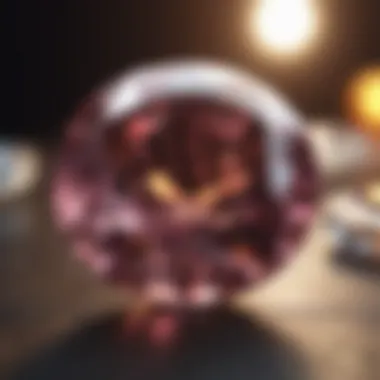
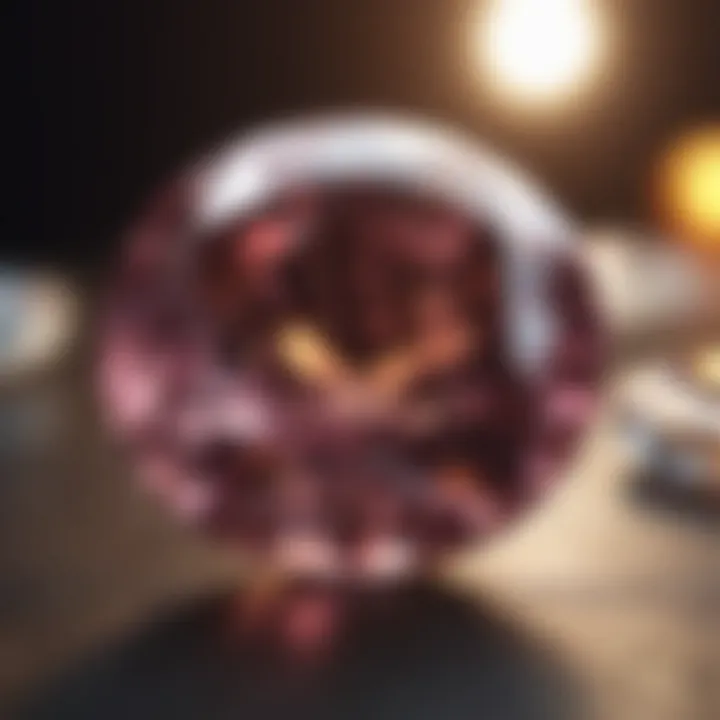
The jewelry setting is where your gemstone truly shines, both literally and figuratively. A good setting not only enhances the appearance of the stone but also protects it. The choice of metal—be it gold, silver, or platinum—plays a crucial role in complementing the gemstone.
What makes this choice important is how it impacts the durability and overall aesthetics of the ring, earring, or pendant. For instance, softer metals might wear down faster under daily use, whereas harder metals may offer better longevity.
- Advantages: A thoughtful choice in settings can help avoid damage to the stone while providing a stylish look.
- Disadvantages: Some consumers may be tempted to skimp on settings to save cost, which could lead to future disappointment if the stone becomes loose or tarnishes quicker due to poor craftsmanship.
Care and Maintenance
Cleaning Methods
Proper cleaning methods are essential for maintaining the sparkle and integrity of your diamonds and cubic zirconia. A simple cleaning solution can do wonders. For diamonds, a gentle mix of warm water and mild dish soap is often recommended. Dip a soft brush to remove grime carefully without scratching the surface.
For cubic zirconia, the same cleaning solution works well, but routine deep cleaning is less vital as its synthetic nature avoids many natural blemishes. Regular cleaning can prevent build-up that might dull its appearance.
- Advantages: Frequent, simple cleaning helps maintain the visual appeal and can prolong a stone's overall lifespan.
- Disadvantages: However, using harsh chemicals can harm the stones, so it's key to stick with gentle methods.
Storage Recommendations
When it comes to storage, keeping your stones safe from scratches is vital. A soft pouch within a jewelry box with individual compartments can shield your gems from unnecessary wear. Ideally, avoid keeping them together, as the hardness of a diamond can scratch a cubic zirconia and vice versa.
The unique feature of this storage practice is its simplicity and efficacy. Protecting your jewelry not only keeps it looking pristine but can also enhance longevity significantly.
- Advantages: Proper storage contributes to long-term care, making it a worthwhile investment for consumers.
- Disadvantages: Yet, neglecting this aspect can lead to costly repairs or replacements if stones are damaged.
Proper care and consideration in purchasing settings can transform a mere piece of jewelry into a cherished heirloom.
In summary, practical considerations provide a roadmap for consumers navigating the complex facets of the gem market. By paying attention to quality, settings, and maintenance, buyers can ensure that their investments bring satisfaction for years to come.
Future Trends in the Gemstone Market
The gemstone market is an ever-evolving landscape characterized by shifting paradigms and trends that resonate deeply with both consumers and industry insiders. Understanding these future trends isn't just an intellectual exercise; it's about adapting to the changing desires of buyers and harnessing new advancements in technology. The conversation around cubic zirconia and diamonds offers insight into where the market is headed, especially as options available to buyers keep expanding.
Technological Advances
Impact of Synthetic Gem Production
One of the most significant breakthroughs in recent years has been the rise of synthetic gemstone production. This method of creating gems in laboratories efficiently duplicates the conditions that naturally occur within the Earth, allowing gems like cubic zirconia to be produced with remarkable precision. The key characteristic of synthetic gems is consistency; they often balance quality and cost better than mined counterparts. For buyers interested in both aesthetics and price, synthetic gems serve as an attractive choice.
However, it's essential to consider the environmental angle. Since synthetic gems tend to be manufactured in controlled environments, they typically have a lower carbon footprint compared to mined stones. This makes them not just a beneficial choice for many consumers but also a more environmentally conscious one.
"The rise of synthetic stone production reflects a broader shift towards sustainability and ethical consumption in the gem industry."
Emerging Treatments and Enhancements
Alongside synthetic manufacturing, various emerging treatments are pushing boundaries in the gemstone market. Techniques like color enhancement and clarity improvements are now commonplace. These treatments allow for the enhancement of natural stones, making them more visually appealing and valuable.
A fundamental appeal of these enhancements lies in their ability to elevate a gem’s appearance while maintaining its natural essence. This duality is beneficial; it aids in appealing to consumers who are both budget-conscious and quality-driven. However, there is a caveat. Often, these treated stones can face scrutiny regarding authenticity and longevity, a reminder that buyers need to educate themselves on the implications of these enhancements.
Shifts in Consumer Preferences
Shift Towards Ethical Sources
As awareness about ethical practices increases, many consumers are gravitating towards gemstones sourced responsibly. This shift is visible in the heightened demand for transparently mined or lab-grown stones. The growing concern surrounding conflict diamonds — stones that finance violence and exploitation — makes this preference particularly significant. Brand loyalty is now often contingent on a company’s commitment to ethical sourcing.
This focus on ethical sourcing presents an opportunity for brands to differentiate themselves in a crowded market. Consumers who choose ethically sourced stones often feel more aligned with their purchases, believing they are making a difference through their choices. This is a beneficial trend for both sellers and buyers, cultivating a sense of shared responsibility in the marketplace.
Demand for Unique Cuts
Another intriguing shift is the keen interest in unique cuts and custom designs among consumers. Today's jewelers are witnessing an upsurge in requests for personalized pieces that reflect individual styles and stories. This trend has altered traditional design approaches — gone are the days of merely opting for standard cuts because of their commercial appeal.
The demand for unique cuts allows gem enthusiasts to express themselves while also standing out in a world filled with generic offerings. However, this trend necessitates collaboration between consumers and jewelers, ensuring that quality and craftsmanship remain prioritized. Customization is more than just a fleeting trend; it is shaping the future of jewelry design in significant ways.
Ultimately, understanding these future trends allows consumers to make more informed decisions while ensuring they align with their values and lifestyles. The gemstone market continues to innovate, constantly reshaping our approach to purchasing and valuing gems. By maintaining awareness of these trajectories, buyers can navigate the complex landscape with confidence.
End
When it comes to understanding the intricate worlds of cubic zirconia and diamonds, the conclusion serves as a critical touchstone. By weaving together the diverse elements discussed throughout the article, this section not only sums up the contrasting features of these two gemstones but also highlights their respective significance in today’s market. Grasping these differences is not merely an academic exercise; it carries real-world implications for consumers, jewelers, and investors alike.
Summary of Key Points
In the preceding sections, we explored several vital aspects of cubic zirconia and diamonds:
- Origins and Formation: Diamonds have a natural occurrence and form deep within the Earth over millions of years, while cubic zirconia is a human-made stone, developed in laboratories in the mid-20th century.
- Physical Properties: Diamonds are renowned for their unparalleled hardness and optical brilliance, whereas cubic zirconia, while durable, lacks the same level of refractive quality that gives diamonds their unique sparkle.
- Market Trends: Diamonds traditionally hold a strong market value influenced by rarity and prestige, whereas cubic zirconia is generally more accessible, providing a budget-friendly alternative for those seeking the aesthetic qualities of more expensive stones.
- Consumer Preferences: Emotional and cultural perceptions shape consumer choices, resulting in a preference for diamonds in special occasions, such as engagements, whilst cubic zirconia appeals to those wanting a stylish piece without the hefty price tag.
Final Remarks on Choices for Consumers
In navigating the choices between diamonds and cubic zirconia, consumers must weigh factors such as budget, emotional significance, and personal taste. A diamond might be a meaningful investment for some, reflecting timeless beauty and lasting value. On the flip side, cubic zirconia can provide undeniable sparkle at a fraction of the cost, making it a practical option for everyday wear or special occasions without the weight of investment concerns.
Ultimately, understanding these key differences equips consumers with the knowledge to make informed decisions. Whether one opts for a lavish diamond or a stunning cubic zirconia, what matters most is the joy and meaning that these gemstones bring into their lives.
"The choice between a diamond and cubic zirconia is as much a reflection of personal values as it is about aesthetics."
By analyzing both sides of the coin, consumers can adhere to their individual preferences while appreciating the beauty each gemstone has to offer.







